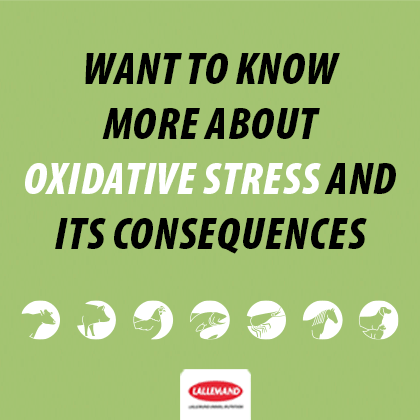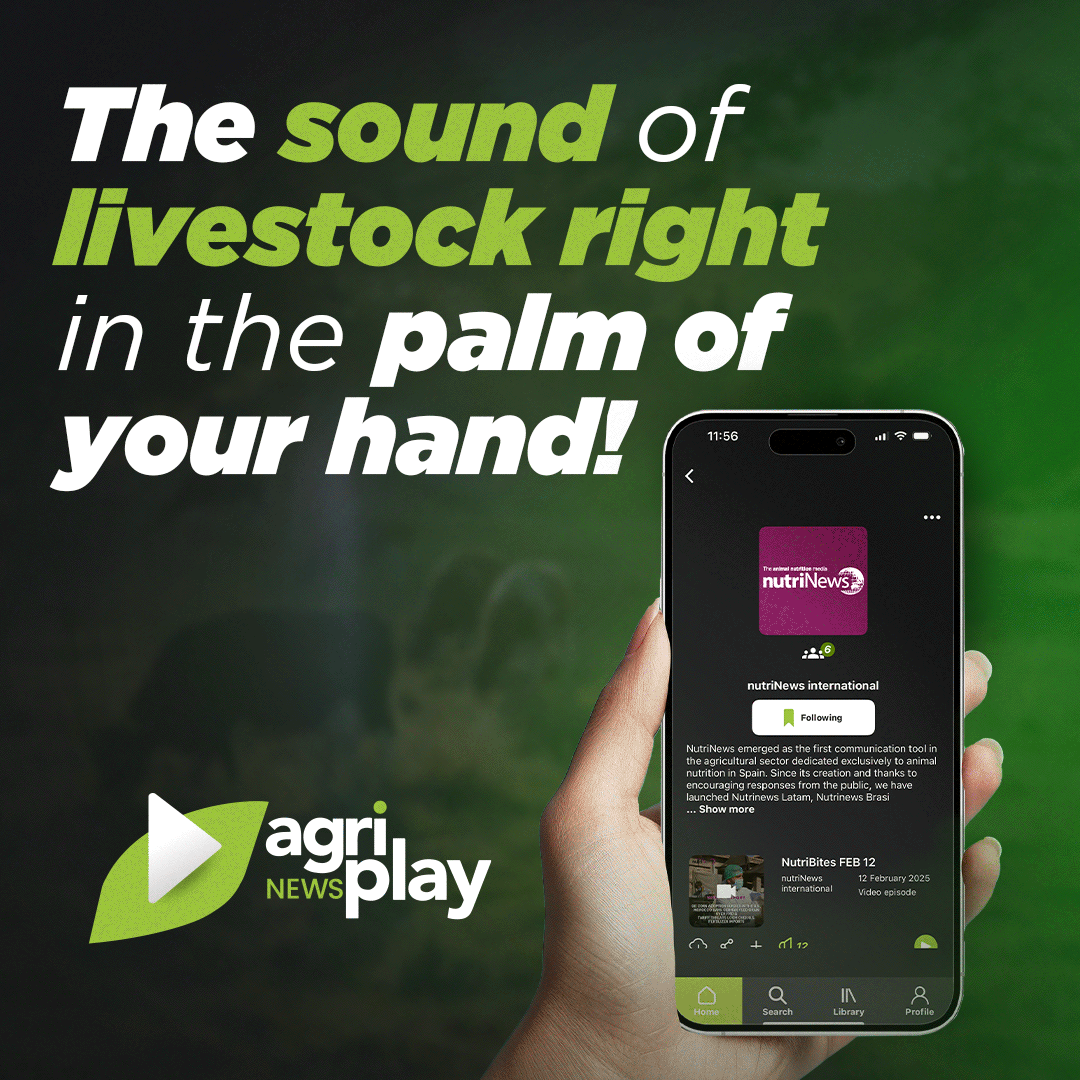Introduction
Fat soluble vitamins (vitamins A, D, E y K), as well as other vitamins represent a group of essential micronutrients for animals because they act as enzyme precursors or coenzymes in various metabolic and immunologic processes. Therefore their presence is necessary for:
- facilitating a correct metabolism.
- eliciting an adequate immunological response.
- maintaining a normal physiologic function.
- and in summary promoting growth, health, and welfare in animals.
However when it comes to fat soluble vitamins there is a misconception that because they are stored in the liver, adipose tissue, and skeletal muscle their addition to animal feed in sufficient quantities is not always critical.
The prevalence of fat soluble vitamins’ deficiencies in supply animals due to insufficient diets or malabsorption presents a problem for their growth and health. Affecting the quality and longevity of products derived from these animals also.
The disappearance of growth promoting antibiotics almost 16 years ago, as well as drug restrictions for animal use (i.e colistin few years ago and Zinc Oxide in the pig industry in a near future) added to the trend of greater vaccine use, has created a scenario where supply animals depend much more on their immune competency to deal with the health challenges posed by intensive production models.
Although there is a great offer of zootechnical additives and analogous products proven to work as replacements for antibiotics used previously, the addition of a greater vitamin input in animal feed is indisputable considering they are a key part of the immune response.
On a side note the constant improvement in conversion indexes as a result of genetic selection generates greater vitamin demands in animal feed in order to fulfill such genetic potential.
⇒ The following article contains a review of some of the latest scientific publications on the effects caused by the supplementation of high levels of fat soluble vitamins in monogastric supply animals.
Vitamin A
This vitamin is well known for being involved in the modulation of the immune system, as well as having a role in preserving intestinal integrity, cell division, bone development and vision related processes.
According to recent studies, Vitamin A levels of 1500 UI /kg of feed result in maximum yields for broiler chickens and layers.
Recently Savaris et al. (2021) set up a trial with Cobb chickens (500 ind.) fed during their entire production cycle (1-42 days) with varying levels of Vitamin A supplementation added to the base diet which had 8,000 UI/kg:
[register]
- 0 0 UI /kg of feed
- 3000 UI /kg of feed
- 6000 UI /kg of feed
- 12000 UI /kg of feed
- 24000 UI /kg of feed
The results from this study showed a quadratic response for weight gain, resulting in a maximum response of 15527 UI Vitamin A/kg from day 1 to 21, and day 21 to 42 respectively.
The maximum weight gain at the end of the productive cycle according to the predictive equation obtained from the quadratic response was estimated at 3206 g (Figure 1).
Figure 1. Weight gain in chickens 1 to 42 days old, fed with a diet with varying levels of Vitamin A

Abd El-Hack et al. in 2016 estimated similar vitamin A levels (16000 UI/Kg od feed) in Bovans laying hens subjected to heat stress( >30ºC), leading to improvements in productive yields as shown in figure 2 y 3.
Figure 2. Effects of vitamin A supplementation in egg mass (grams) in laying hens 42 to 54 weeks old under heat stress conditions.
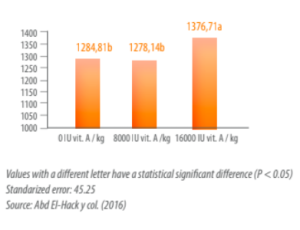
Figure 3. Effects of vitamin A supplementation measured in Haugh units for eggs produced by layers (50 weeks old) under heat stress conditions

| This positive effect linked to high levels of Vitamin A in laying hens under heat stress and broiler chickens with high productive yields susceptible to caloric stress, is due to the the key role that Vitamin A plays in the avian immunologic system. |
» As highlighted recently by Shojadoost et al. (2021), vitamin A has anti inflammatory activity and modulates both cellular and humoral immune responses in poultry.
Therefore Vitamin A is essential for the immunological functions of the mucosa, intestines and systemically.
The importance of vitamin A in immunological function has been evidenced in multiple studies amongst which that of Yvan et al. (2014) deserves to be mentioned. These authors observed that birds which were fed with a diet containing 2.000 UI of vitamin A/kg presented a higher inmune response (antibody titers) to the Newcastle virus vaccine.

Positive effect of high levels of vitamin A in the lactogenic immunity of pregnant sows
High levels of vitamin A have also shown a positive effect in the immune response of pigs.
Langel et al. (2020) supplied high levels of vitamin A (30000 IU/day) to guilt sows infected with porcine epidemic diarrhea virus (PEDV) from day 76 until the end of the lactation period. They observed a reduction in the excretion titers of viral RNA and in the severity of the diarrheic condition.
In addition to the previous results, the supplementation of 3.000 IU of vitamin A had a positive effect in the litters’ survival rate (74.2% vs 55.9%).
This can be explained through lactogenic immunity. Based on the fact that the guilt sows which received high levels of vitamin A supplementation had an increase in the number of anti (PEDV) IgA secreting cells, greater levels of IgA in prenatal serum, as well as higher IgA and B7 present in milk.
Besides modulating and stimulating the immune response, vitamin A helps to regulate intestinal stem cells, having a positive impact in intestinal growth and function. As observed by Wang et al. (2020) in piglets (Yorkshire x Landrace) x Duroc) weaned at 21 days.
In these studies various doses of vitamin A were supplied:
- 2 mg/kg
- 4 mg/kg
- 8 mg/kg
- 16 mg/kg
These were administered for a 14 day period post weaning. It was seen that a greater epithelial growth, and a significantly higher expression of maltase and sacrase was obtained with a dose of 4 mg/kg (13333 IU vitamin A/kg).
In addition to this, the authors were able to demonstrate that there is a linear response between the average daily weight gain and the supplementation of vitamin A. As well as with the weight gain:feed consumption quotient as shown in figures 4 and 5.
In other words, a higher level of vitamin A in feed represents a better use of it by the animals and greater growth.
Figure 4. Average daily weight gain in piglets (8 to 14 days post-weaning) with different levels of vitamin A in feed.
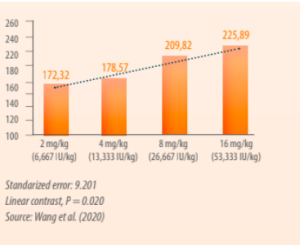
Figure 5. Weight gain : feed consumption quotient in piglets(8 to 14 d post-weaning) with different levels of vitamin A in feed.
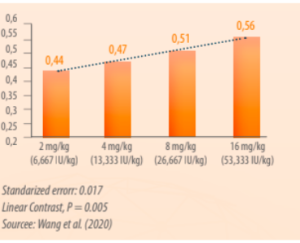
Vitamin D
Vitamin D3 has to go through two hydroxylations within the liver and kidney in order to acquire its 25(OH)D3 1,25(OH)2D3 forms.
The active biological metabolite is 1,25(OH)2D3. It acts in various physiological processes, including immune response modulation, regulation of bone and mineral metabolism amongst others.
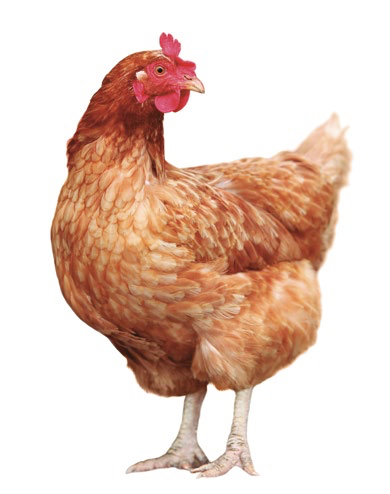
| The combined administration of 5000 IU vitamin D3 / kg and 69 mg of 25(OH)D3 /tn stimulates the immune response, bone mineralization and growth in broiler chickens and layers. |
The positive effect of vitamin D3 and its metabolite 25(OH)D3 in the immune response was confirmed by Vázquez et al. (2016) in broiler chickens (Ross 308) fed with 200 or 5000 IU of vitamin D3 / kg and with 0 or 69 mg de 25(OH)D3 / tn from 1 to 21 days old.
On this same note the highest antibody titers against Newcastle virus were found in those birds that had received 5000 UI of vitamin D3/kg combined with 25(OH)D3, without the detection of interactions between these two forms of vitamin D as shown in figure 6.
Figura 6. Antibody titers for Newcastle virus in broiler chickens (21 d) fed with different levels of vitamin D3, with or without 25(OH)D3

The combined administration of the two forms of vitamin D also resulted in significant gains in bone mineralization, and overall growth.
Similar studies carried out in laying hens by Wen et al., 2019; Chen et al., 2020; and Wang et al., 2020, showed that when these hens received levels higher than 5000 IU of vitamin D3 / kg of feed and/or 25(OH)D3. they presented maximum responses regarding:
- bone mineralization
- quality of egg shell
- and productive yields
Very recently, Zhang et al. (2021) reported that the addition of 69 mg of 25(OH)D3 / tn of feed is a highly efficient tool for reversing bone mineralization problems caused by intestinal inflammatory processes in finishing phase chickens.
| Supplementation of 25(OH)D3 in diets for breeding sows has positive effects in the intestinal, bone and muscular development of their litters. |
The effect seen in breeding sows’ litters when their diets are supplemented with 25(OH) D3 (50 micrograms/kg) has been the subject of various studies. Amongst which that of Thayer et al. (2019) deserves to be mentioned. They observed there was a significant rise in the number of muscle fibers in newborn piglets when the sows’ diets received a combined supplementation of 1500 IU vitamin D3 / kg and 50 micrograms of 25(OH)D3 / kg.
Other authors like Zhang et al., 2019, 2020, have demonstrated the positive effects on newborn piglets derived from the inclusion of 25(OH)D3 in maternal diets. Including intestinal development, intestinal absorption of Ca and P, and modulation of the intestinal microbiome. Promoting the colonization of specific bacteria like (i.e. Alloprevatela spp.) which produce short chain fatty acids that contribute to maintaining the integrity of the intestinal barrier and possess certain anti inflammatory activity.
On the other hand these same authors discovered that supplementing the diet of breeding sows with 25(OH)D3 resulted in a an improved mineralization and resistance of their own bones as well as those of their piglets. (Figures 7 and 8, respectively).
Figure 7. Effects of vitamin D3 source used in diets on the femoral and tibial resistance of breeding sows (fracture force).
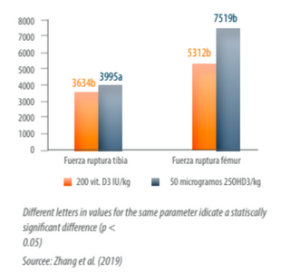
Figure 8. Effects of vitamin D3 source used in breeding sows’ diets on piglets’ tibial and femoral resistance(fracture force).
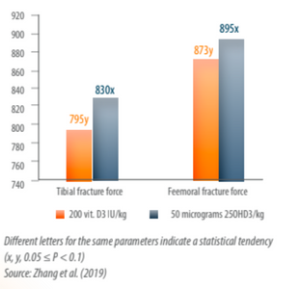
Vitamin E
The antioxidant activity of vitamin E against free radicals and their harmful effects on cellular integrity in both normal metabolic processes and inflammatory states is widely known.
Therefore, supplementation of vitamin E at high doses in animal nutrition not only promotes health, and productive yield, but also contributes to the quality and longevity of derived products.
Under extreme thermal stress conditions, the addition of 400 IU vitamin E /kg of feed improve the productive yield of broiler chickens.
The positive effect that the inclusion of vitamin E and selenium has in broiler chicken diets is especially evident under caloric stress conditions. These are a result of the oxidative stress present in avian metabolism, which compromises their productive performance.
Eikunseiten et al. (2021) observed that by feeding broiler chickens (Ross) with 400 IU vitamin E /kg and 0.2 mg selenium/kg increased their liveweight by 11% and reduced the conversion index by 8%, compared to the addition of 300 IU vitamin E and 0.15 mg selenium /kg; during the finisher phase (Figure 9 and 10, respectively).
Figure 9. Effects of vitamin E levels and selenium on liveweight in broiler chicken diets at 49 d old under heat stress

Figure 10. Effects of vitamin E and selenium levels on the weight gain index of 49 day old broiler chickens under heat stress

This positive effect of vitamin E in the performance of broilers under thermal stress conditions, has to do with its antioxidant activity over physiological stress and its immunomodulatory capacity. (Hridoy et al., 2021).
With the purpose of investigating the effects of vitamin E in avian immune response, Awadin et al. (2020) supplied 200 IU vitamin E /kg in the feed of white Hy-Line chicks which were experimentally infected with avian influenza H9N2. They discovered that such supplementation derived in a greater growth of lymphoid organs (spleen, and bursa of fabricius) as well as resulting in lower viral excretion in trachea and cloaca (Figure 11). Resulting in a greater survival rate of the chicks at 14 days old.
Laying hens have lower vitamin E requirements than that of broilers, or rearing chicks, which doesn’t mean it’s less important for their health.
Figura 11. Effects of vitamin E supplementation in viral excretion titers for avian influenza H9N2 in 14 d old white Hy-Line chicks
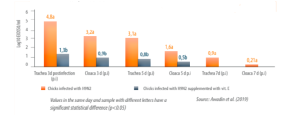
Liu et al. (2019) observed that supplementing layer hens’ feed with 30 IU vitamin E / kg stimulated an immunologic response while at the same time significantly reducing mortality in birds exposed to Salmonella Enteritidis.
Ding et al. (2021), in their studies with vitamin E and laying hens, concluded that 100 IU vitamin E /kg of feed are necessary to raise the levels of antioxidant enzymes in the blood in order to reduce oxidative stress.
Increasing levels of vitamin E in animal feed generate a linear increase of its content in meat, which results in greater quality in the final product.
An important aspect of the supplementation of high levels of vitamin E in animal feed is the subsequent enrichment of these animals’ meat with the same vitamin.
Hence, besides improving the productive yield and animal health, the supplementation of broiler chicken feed with growing levels of vitamin E produces a linear increase of this vitamin within the meat (Pompeu et al, 2018). Translating itself into a qualitative improvement of the final product (Niu et al., 2018; Vieira et al., 2020).
In a very similar way, high levels of vitamin E in pig feed improve antioxidant activity within the muscles which significantly reduces the losses due to the cooking of this meat. (Jin et al, 2018).
Conclusions
The most recent investigations on the inclusion of fat soluble vitamins in animal diets, try to simulate real life scenarios and the challenges faced by the animal production industry under new conditions. Where the use of growth promoters is no longer an option, and there are ever growing restrictions on other drugs also. It is through these studies that the beneficial effects in productive yield and animal health linked to the inclusion of high levels of vitamin in diets have come to light. Demonstrating that this positive impact can also be translated into the final products.
For such reasons, even genetic companies have updated their recommendations with higher inclusion levels of fat soluble vitamins as shown for example in table 1 for chicks, and breeding hens.
Table 1. Specifications for fat soluble vitamins for chicks and breeding hens Ross 308 in 2018 and 2021
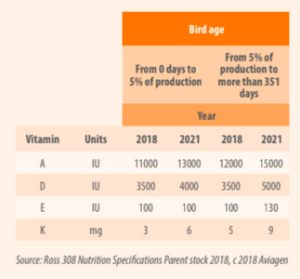
With the constant technological breakthroughs and legislative changes that occur within the fields of animal production and nutrition, the need for a detailed revision of the adequate levels of fat soluble vitamins in premixes and feed is unquestionable.
If you’re interested in any of the mentioned
bibliographic references contact the author: alfred.
[email protected]
[/register] ]




